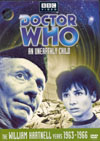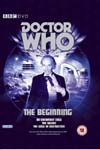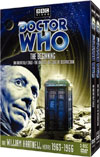DVD Box Set Extras include:
Episode One - An Unearthly ChildAn innocent school mystery opens what will become the longest running science fiction television series in the world. Many strong elements are introduced here for the first time: The signature tune composed by Ron Grainer and brilliantly realised by Delia Derbyshire at the BBC Radiophonic Workshop with her assistant Dick Mills is a grand and beautiful piece to listen to from the start. The then-revolutionary opening title graphics were already in the form that would be used for many years to come. The policeman's atmospheric walk establishing a mysteriously humming police box at 76 Totter's Lane - all these elements have earned a nostalgic place in every fan's heart, and the series would play on that in later years.Cutting to the school with an effective establishing shot in the hallway, teachers Ian Chesterton and Barbara Wright are introduced, where the mystery is quickly told through dialogue. Listen closely though, or you'll miss it - it isn't the most effective way of grabbing an audience's attention, but if you've no distractions going on next to your television set, it does work well. Finally the good Doctor appears on the scene. It is interesting to note how his character is presented differently in the broadcast version of the pilot versus in the rejected footage. In the rejected material, he is written to be a bit too gruff and obstructive, too focused on antagonizing his unexpected guests. However, in the broadcast version, the writing is more balanced and his character is softened, as he is now easily distracted by odd things and stray ideas, becoming more of a likeable absent-minded professor. The rejected material is still fascinating, for where the dialogue is identical with the broadcast version, William Hartnell's performance is a little more on the mark emotionally. The scuffle outside the TARDIS and the all-important first transition into the interior (the only post-production edit allowed for this 1960's half-hour drama) are achieved with much greater brilliance, clarity and impact in the rejected version. Once inside the TARDIS, the rejected version deteriorates slightly. However, two things stand out: Susan's performance becomes brilliant in many places, as she displays an alienness that finally does the episode title justice, and an inner strength and mysterious confidence that would have done her character much credit had she been able to slip it in throughout her later TARDIS travels. Also, the Doctor's reason for abducting Ian and Barbara via take-off is much, much better explained here - a strong belief in not changing even a single idea in the minds of the local 1960's people. The dematerialization sounds very different - much more of a musical sound, with bits of the more common sound breaking through every now and then. This probably only appears to be more alien because the usual TARDIS sound has become so familiar since then. However, we can be thankful for many things in the broadcast version. Technically, it is simply much better executed, in terms of acting, camera-work, timing, etc. The TARDIS interior scene is free from several persisting scenery distractions that plagued the rejected version. The Doctor and Susan's explanations of themselves also better fit the ongoing continuity of the show. Unfortunately, Susan wears a completely different costume in the two versions, so even with today's editing a version combining the best of both pilots (and the best of her alien character) would show this major continuity problem. Once in the TARDIS in the broadcast version, Susan is more of an ordinary 60's human teenage girl than ever. Putting comparisons of the two pilots aside, this half-hour episode is good riveting sci-fi mystery and drama. An excellent start for the series. The cliffhanger is also quite well done.
Episode Two - The Cave of SkullsShowing this episode back to back with the pilot on November 30, 1963 was one of the best moves that producer Verity Lambert ever fought for. "An Unearthly Child" and "The Cave of Skulls" complement each other beautifully. Although the main guest characters of the tribe are introduced well, the main action is solidly on the four time travellers, who come to grips with the real heart of all good science fiction: exploration. Here, they discuss time travel theory, explore a new world, and investigate more of the myth and "nuts and bolts" of the Doctor Who series as a whole. This episode owes its success to being all about exploring both the new world and the Doctor.Once the Doctor is captured, however, things begin to slide downhill, with Susan panicking and turning into a jellyfish. Much anticipation goes into the Doctor's first encounter with the tribe, and it's an okay scene, but it could have been so much more if the Doctor had had wits for cleverer dialogue. Suddenly confusion breaks out, and it is many long seconds later before one can make out the fact that Ian and Susan and Barbara have descended on the tribe and attacked them. The cliffhanger is nothing to get too excited about as the travellers are hastily stuffed into a cave containing skulls. Barely time to make sense of this episode's title, and it's all over.
Episode Three - The Forest of FearThe Doctor's first television adventure story has its strengths and its faults, and these begin to polarize in episode three. Generally, the interaction between the four time travellers is quite good, as they get to know each other and their different values and priorities begin to clash. The question of leadership arises for them - the Doctor is used to having Susan follow his instructions on their travels, but now Ian and Barbara challenge his authority.The interaction between the various members of the tribe also works well, and for much the same reason. Leadership needs to be decided on, and the plot and drama unfold very much like an Elizabethan/Shakespearean play, although without the famous bard's poetic, metaphoric dialogue. The story's biggest problem is in the main action plot, in the interaction between the time travellers and the tribe. Even though all the members of the tribe can express their complex ideas well through the simplest words (something all students of English should study), the time travellers persist in talking down to them, not explaining their ideas truthfully to the best of their ability, and unfairly treating the tribe people like children. The time travellers also have no goals in this time-space location - their only aim is in getting away, and this type of story-line will always encourage an audience to lose interest in the location as well. Episode three does contain the best example of the break-away from these problems - a wonderful cinematic moment as an unseen beast attacks in the forest, and all the humanoids present find themselves on the same side for once. Barbara leads the heroic charge, with Ian deciding to support her once her mind is set, and this seems to be a moment that the Doctor reluctantly learns a lot from. This is quite possibly the best moment in the tribe half of the story. It could have been even better, if Barbara's well-written moment had been acted out with less panic and desperation and more resolve and determination, but Jacqueline Hill would soon learn and shine brighter in such moments later on. The cliffhanger works fairly well as an unfortunate surprise, although it doesn't do much in the way of creating anticipation for a new and exciting next episode. Rather, hang in for more of the same.
Episode Four - The FiremakerThe Doctor takes charge of the mob scene and solves a minor plot mystery with both intelligence and charisma. A great moment, and long-time Doctor Who fans might begin to suspect that their hero will finally take charge in this story. Unfortunately, his heroics will be kept to just a few psychological asides to Ian and Za throughout the rest of the episode. Za makes a quick physical recovery, apparently trading his wounds in for a sudden ethical retardation. Well, I guess we shouldn't expect too much from a primitive tribesman with a taste for power, even if authority over the tribe is his birthright.The episode then revolves around fire, and is not so much about the first discovery of fire (which would really threaten to create a catch-22 time-loop if Ian learned it from his ancestors and then went back in time to give it to them all over again). No, human tribes everywhere have the secret of fire already at this time-period. This episode is about the use of the making of fire as a symbol of power, something to be kept secret among tribe leaders to help them hold their high position. Slowly the story begins to wrap itself up. The Elizabethan power-struggle between Za and Kal comes to a predictable, but somewhat satisfactory conclusion. However, the time-travellers appear somewhat bored, tired, and turned-off by most of the proceedings, disappointed with the outcome, and anxious to be on their way. Can you blame any audience for feeling it with them? The power-struggle between the Doctor and his two new human companions also appears to be resolved as Ian admits that the Doctor is leader of their "tribe". Although this pleases the Doctor enormously, is it really true? It is Ian who seizes upon Susan's inspiration and comes up with the plan for their escape. The role of leader / main character / hero was still not, as the dialogue had suggested, set in stone, and would not be for much of the William Hartnell era. It is with a great sense of relief that the four travellers finally enter the TARDIS. Gone is primitive drama, and science fiction returns to rule. The Doctor undertakes the final climactic act of the story, although since this is merely to set the time machine in motion and we learn from later stories that they would have already been extremely safe as soon as they closed the doors, it isn't all that thrilling in the heroic sense, even though it was shot and directed very dramatically. The police box makes its first visual dematerialization, and the moment works well. The Doctor makes a few overly-technical excuses for his lack of ability to navigate the TARDIS, another first example in the series of one of the Doctor's key mannerisms. Finally we are left with the best cliffhanger in the story, as the TARDIS lands in a place that "could be anywhere", a short teaser that enticingly invites viewers to the exploration of "The Dead Planet" Skaro in the next episode.
DVD PresentationDVD releases of future Doctor Who stories are great for typically spoiling us fans with engaging audio commentaries on EVERY episode, in addition to many other special features that put most other television shows to shame. So it is a bit strange here that only some of the episodes have audio commentary, especially since director Waris Hussein is so lively and full of interesting bits of information. I really wish he'd been allowed to lead a commentary on all episodes, with or without a moderator's help. At least we get a lot of really rich documentaries and featurettes on the third disc of this set, making this a very worthwhile and essential collection to own.
International Titles:Deutsch (German): "Doctor Who": "Das Kind von den Sternen"
Magyar (Hungarian): "Ki vagy, doki?": "Egy földönkívüli gyerek"
It comes across as a very informal, familiar "Who are you, Doc?" Yes, there is actually an announcer saying this over the title on episodes that have been dubbed into Hungarian.
Français (French): "Docteur Who": (Une enfant qui ne vient pas de la Terre)The English novelization by Terrance Dicks was later translated into French under the new title "Docteur Who entre en scène".
Русский (Russian): "Доктор Кто": "Неземное дитя"
The standard "ребёнок" might better describe a teenager / adolescent.
Italiano (Italian): "Doctor Who": "La ragazza extraterrestre"
"La ragazza extraterrestre" is available in "Gli inizi" - their version of "The Beginning" 3-story DVD box set. Español (Spanish): "Doctor Misterio": "Una Niña Que No Es De Este Mundo"
Evidence suggests this was only done for 12 of the 17 stories from the first two seasons, omitting the historical stories "Marco Polo", "The Reign of Terror", "The Romans", "The Crusade", and "The Time Meddler". The special M/E tracks were then used to create full speaking audio tracks in languages such as Spanish, Arabic, and possibly Farsi. Spanish dubs for all 12 stories were recorded in Mexico, and used to create Spanish-language master film negatives at the BBC. Positive prints from these were then shown in Latin American countries like Venezuela, Mexico, Chile, and Costa Rica. Spain itself, however, would not discover the Doctor's television adventures until episodes starring Tom Baker (the 4th Doctor) were on offer....
This story has become available on DVD as the first adventure in "The Beginning" DVD box set. Although the popular original edition from 2006 has now become a rare item, a newer 2013 re-issue offers identical content at a more competitive price... The Amazon symbols are also links that will open a specific Amazon page for the selected product in a new window. Click on the amazon symbol for your area to open amazon's page and see additional product information before purchasing.
Comments on this article are welcome. You may contact the author from this page:
|
||||||||||||||||||||||||||||||||||||||



 2013
2013 2013
2013



